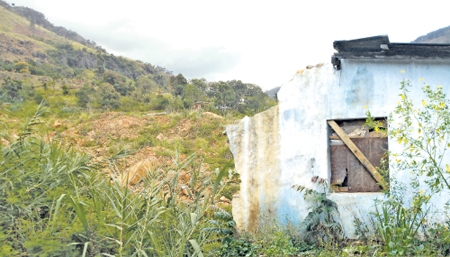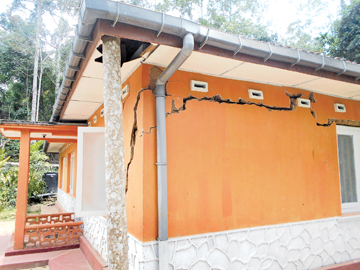When the mountains rumble
by Rukshana Rizwie
In a year since 37 people were buried alive under a mountain of mud
in Meeriyabedda in Koslanda, researchers and families affected by the
tragedy have often asked what the authorities have done since, to avert
these disasters or insulate them. The responses have been lukewarm and
uncertain.
 |
|
A house that was damaged in
the Meeriyabedda landslide |
The Meriyabedda landslide was one of the deadliest landslides in
recent history. Rainfall data from the Poonagala gauging station
revealed that the amount of precipitation which poured into the area
exceeded 500 mm. This caused a destabilization in the area above the six
state line houses, which was already identified by National Building
Research Organization (NBRO) as a landslide risk area. The mound of mud
which came downhill flattened the entire township, wiping it off the
map. What was left then was a sludge of mud and water and still is
to-date.
It is human nature, if not the Sri Lankan way, to hear of looming
potential disaster and pretend it would pass away. The Haldumulla
Divisional Secretariat and the National Building Research Organization (NBRO)
which received a barrage of criticism for its lackadaisical approach had
as far back as 2005, identified the area as landslide prone.
In 2011, a threat of a landslide was imminent, but warnings were
ignored. The NBRO by itself does not have the authority or legal
mechanism to aid or abet resettling activities.
Empowering NBRO
"The NBRO is not empowered by a Parliament Act giving the due
recognition and legal provision it needs to carry out its activities,
effectively," said Mahesh Somaratne, Vice President of the Geological
Society of Sri Lanka and a senior geologist at the NBRO. "The NBRO lacks
the mandate to resettle people living in vulnerable areas or to adopt
mitigatory measures in such areas."
He adds that the scarcity of adequate lands to the state also hinders
the resettlement process. "In most instances, people do not want to
vacate their homes, though they have been informed about their risks.
This happens even after they've received a new place to move to, simply
because the immediate threat is not visible on the ground."
The NBRO is the sole responsible state agency that can identify
high-risk areas and provide guidelines to relevant authorities. While
mitigation proposals are being prepared by the NBRO, there aren't proper
mechanisms on the ground to put into place the mitigation measures.
"The NBRO has been directed to prioritize the areas, as such they are
attended to once they've been identified as high risk. The govt also
introduced a circular in 2010 which makes it compulsory for companies to
obtain a suitability certificate from NBRO prior to constructions within
the declared landslide prone areas. To undertake these activities
effectively, the capacity and resources of NBRO must be upgraded."
|

Cracks have appeared in Bandarawela homes due to the Uma Oya
project |
He adds that since the NBRO is not reliant on the treasury, it is
difficult to cope with the additional workload without the backing of
the state or necessary facilities.
Where are the houses?
A total of 321 persons from 88 families were affected by the Koslanda
landslide, most of them are still languishing at the Mahakanda Factory
Welfare Camp. A group of families staged a protest last week demanding
that they be resettled.
Shiromi Jeewamala, Divisional Secretary of Haldumulla said, steps are
being taken to provide homes to the families who were affected by the
landslide. The official stance as echoed by Anura Priyadarshana Yapa,
the Minister of Disaster Management is that the houses would be
completed early next year. How soon, no one knows.
The Minister cited that logistical issues to supply the construction
materials as the snag. He added that the relevant plantation company had
expressed their willingness to provide lands required and resolve the
logistical matters. Earlier this year, Minister of Infrastructure and
Community Development Palani Digambaram said the construction of houses
would commence at the end of February.
Ravindra Kariyawasam, who heads the Centre for Environmental and
Nature Studies (CENS) said that the government has promised to build
homes for only 50 families and so far three houses have been partially
built. He added that the government has refused to provide homes for 20
other families because they were not present in Meriyabedda during the
landslide.
Landslides foretold
"Landslides are often set off by heavy rains and while it may strike
suddenly, they are hardly random," said Dr. Ranjana Piyadasa, a
professor of Engineering Geology at the Department of Geography at the
University of Colombo. "Due to the advances in science and technology
geologists can identify landslide-prone lands, even if it is difficult
to predict, when they will fail and how far they will travel when they
do."
Dr Piyadasa referred to the Uma Oya project which is tipped to
recommence, saying that while the Environment Impact Assessment reports
showed that the constructions would not adversely affect the geology of
the land, the impacts are now visible and far-reaching.
"Wells which were the only source of water for residents in the area
have now ran dry in the region, " he said. Researchers have also
observed unnatural patterns in the geology of the area and can say with
certainty that the project is the biggest contributing factor for
landslides."
He adds that the use of heavy machinery, explosives, grilling and
blasting methods used for rock breaking and tunnel boring will only make
the surrounding areas prone to landslides. These actions he says are
destructive, irreversible and cannot be remedied.
Kariyawasam added that homes in and around the Bandarawela town are
showing visible damages and cracks as a result of the resumption of the
Uma Oya project.
"We are told that residents in the area are up in arms over the
matter and have asked the Pradeshiya Saba to intervene," he said.
"Authorities are now supplying over 100 000 litres of water to residents
in the area because wells have ran dry. Officials have acknowledge that
the project was the main cause and have been supplying water in this
manner for the last three months."
They say an act of God is a legal term to describe events outside of
human control where no one can be held responsible. Earthquakes are
examples.
The Koslanda landslide, arguably the greatest tragedies that
afflicted the marginalized and poorest community, was not an Act of God.
The signs were there and continuing to prop up in other locations. But
who will act and when is a matter for us to decide. |

